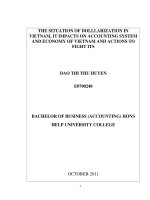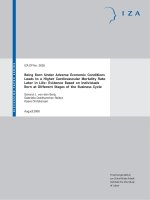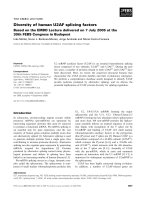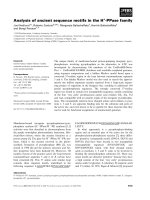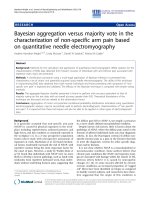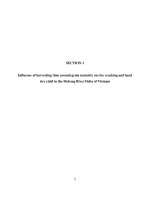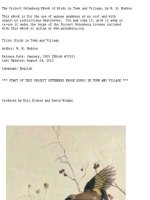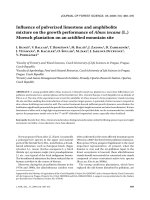Measuring the influence of bloggers in their community based on the h index family
Bạn đang xem bản rút gọn của tài liệu. Xem và tải ngay bản đầy đủ của tài liệu tại đây (288.63 KB, 12 trang )
Measuring the Influence of Bloggers in Their Community
Based on the H-index Family
Dinh-Luyen Bui, Tri-Thanh Nguyen*, and Quang-Thuy Ha
Vietnam National University, Hanoi (VNU),
University of Engineering and Technology (UET)
{luyenbd_54,ntthanh,thuyhq}@vnu.edu.vn
Abstract. Nowadays, people in social networks can have impact on the actual
society, e.g. a post on a person's space can lead to real actions of other people in
many areas of life. This is called social influence and the task of evaluating the
influence is called social influence analysis which can be exploited in many
fields, such as typical marketing (object oriented advertising), recommender
systems, social network analysis, event detection, expert finding, link prediction, ranking, etc. The h-index, proposed by Hirsch in 2005, is now a widely
used index for measuring both the productivity and impact of the published
work of a scientist or scholar. This paper proposes to use h-index to measure the
blogger influence in a social community. We also propose to enhance information for h-index (as well as its variants) calculation, and our experimental results are very promising.
Keywords: social network, influence of blogger, h-index.
1
Introduction
In real life, people usually tend to consult others (e.g. family members, relatives,
friends, or experts) before making decisions, especially important ones. As reviewed
by [1], 83% of people ask others for experience before trying a restaurant, 71% of
people do the same before buying a prescription drug or visiting a place, and 61% of
people talk to others before watching a movie. Thanks to the characteristic of social
networks that makes the information distribution almost at real-time, it leads to the
change of daily behaviors of people who participate in a social network. For example,
before buying a certain product (e.g. a mobile phone), people tend to search for others'
available comments, experiences or evaluation on the product. As a result, if the content of a user's post is interesting and reliable, it can have a certain impact on other
people in that network community. In other words, people have one more source of
consultant affecting their daily habits.
A recent typical example that shows the influence of a user on a social network on
economy is two tweets of Carl Icahn on Tweeter in August 2013: “We currently have
a large position in APPLE. We believe the company to be extremely undervalued.
*
Corresponding author.
T.V. Do et al. (eds.), Advanced Computational Methods for Knowledge Engineering,
Advances in Intelligent Systems and Computing 282,
DOI: 10.1007/978-3-319-06569-4_23, © Springer International Publishing Switzerland 2014
313
314
D.-L. Bui, T.-T. Nguyen, and Q.-T. Ha
Spoke to Tim Cook today. More to come”, and “Had a nice conversation with Tim
Cook today. Discussed my opinion that a larger buyback should be done now. We
plan to speak again shortly.” The two tweets had a big impact on Apple's stock market. The value of Apple's stocks increased more 12 billion US dollars with about
200.000 stock transactions soon after the appearance of the tweets. Such fact raised a
new topic called social influence analysis which evaluates the influence capacity of a
user (in a social network) on the others. In other words, it evaluates how much an
action (described in a user's post) can lead to certain actions of other people in the
community as well as real society.
N. Agarwal et al. [1] proposed a model (called iFinder) which attempts to figure
out top k influential bloggers having highest scores. The key idea is to score all the
posts of bloggers in a community, and select the highest score of one's posts to be
his/her influence score (more details of the model will be given in Section 2). Naturally, influence score should be a value that is accumulatively calculated and increased
over new posts. Hence, if the influence score relies on only one post, we do not take
the contribution of other posts into account, and it does not seem reasonable. In addition, such a score is not reliable in some situations, such as spamming in which
spammers simply make some effort to increase the score of only one of his posts.
Though the authors claimed that it is possible to use the mean score of all posts as the
influence score, this calculation method, again, has a drawback, i.e. it takes into account both influential and non-influential posts. Finally, based on the fact that the life
time (time to have attention) of posts in social networks is short, if we rely on a single
post score, and when this post is obsolete, it is not reasonable to use its score as blogger’s score.
In this paper, we propose to apply the h-index [8] to calculate the influence score
of bloggers which will better reflect the reality. The h-index was proposed by Hirst to
measure both the productivity and impact of the published papers of a researcher. If a
researcher has N published papers in which there are h papers (h≤N) each of which
has at least h (inbound) citations, then his h-index is h. It is easily noted that the productivity is the number of papers (h) that have impact (as the number of citations h).
When the h-index is applied to rank bloggers, we do not rely on a single post anymore, and also calculate non-influential (or less influential) posts.
However, as we can see, the h-index does not take outbound citations into account.
This is not appropriate for social networks where inbound and outbound links and
other related information play the role of essential constructs for information navigation and distribution. In this paper, we propose to utilize the post score of iFinder
which incorporates several properties (besides inbound links) in the first step of hindex calculation.
The next problem we faced in this work is that the posting score of iFinder is a real
number (in the range of [0..1)) which cannot be directly used for the h-index calculation. We use two methods to convert a real number post score to an integer for hindex calculation. Finally, since the h-index was introduced, there have been several
proposed variants with improvements. In this work, we also calculated influence score
using h-index variants for evaluation.
Measuring the Influence of Bloggers in Their Community Based on the H-index Family
315
The rest of the paper is organized as follows. Section 2 briefly introduces related
work. Section 3 presents our model to calculate influence scores. Section 4 shows the
experimental results and evaluation. Finally, Section 5 concludes the paper and gives
some potential future directions.
2
Related Work
2.1
Influential Blogger Identification
The people whose experiences, opinions, and suggestions are sought after are called
the influentials [2]. As stated by M. Momma et al. [13], social influence has two
forms: the first one is the action (or behavior) (stated in the post) itself, and the second
is that this action can lead to the action of other people. The second form is the object
of this paper that reflects the impact of influential on other individuals in the community. As reviewed in [1], the identification of the influential bloggers can benefit all in
developing innovative business opportunities, forging political agendas, discussing
social and societal issues, and lead to many interesting applications [5, 7, 10, 11, 12,
14]. For example, the influentials are often market-movers. Since they can influence
buying decisions of the fellow bloggers, identifying them can help companies better
understand the key concerns and new trends about products interesting to them, and
smartly aspect them with additional information and consultation to turn them into
unofficial spokesmen. Approximately 64% advertising companies have acknowledged this phenomenon and are shifting their focus toward blog advertising. As representatives of communities, the influentials could also sway opinions in political
campaigns, elections, and aspect reactions to government policies. Tracking the influentials can help understand the changing interests, foresee potential pitfalls and
likely gains, and adapt plans timely and pro-actively (not just reactively). The influentials can also help in customer support and troubleshooting since their solutions are
trustworthy in the sense of their authority in term of being influentials.
The influential blogger identification can be roughly defined as: Given a set of M
bloggers (in a certain community), find out K (
) bloggers who have highest
scores (according to a certain estimation).
Nitin Agarwal et al. [1] proposed a model called iFinder for calculating blogger influence score, which will be introduced in detail in Section 3.
2.2
H-index Family
In this section, we briefly introduce h-index as well as its variants which will be used
in our research.
The h-index was proposed by Hirsch in 2005 [8] to be used as an index of a scientist or scholar. It is defined as follows:
A scientist has index h if h of his/her Np papers have at least h citations each, and
the other (Np h) papers have no more than h citations each.
316
D.-L. Bui, T.-T. Nguyen, and Q.-T. Ha
Let C be the set of top most cited papers of a scientist, U be the set of all the scientist's papers, cite(p) be the function returning the number of citations to paper p, then
the h-index h of the scientist is defined as follows:
max| |
,
| |
\ ,
| |
(1)
For example, a scientist published 6 papers. Assuming that for two top most cited
papers, each has 6 references, while each of the rest has 2 references. Then the hindex of this scientist is 2. The common sense of the h-index is that it increases as the
number of papers and citations accumulate, and thus it depends on the 'academic age'
of the scientist. It also has quantitative aspect: As reviewed by the author, for physicists, a value for h of about 12 might be typical for advancement to associate professor
at major research universities. A value of about 18 could have a full professorship;
15–20 could gain a fellowship in the American Physical Society; and 45 or higher
could mean membership in the United States National Academy of Sciences. This
indicates the h-index to be a stable and consistent estimator of scientific achievement.
Thus, it is currently used to rank objects bigger than a person, such as a department, a
university, a country or a journal.
L. Egghe [6], in 2006, argued that h-index has a problem of assigning the same
weight to all papers that contribute to h-index, since when a researcher has the index
h, and one of his papers has much more citations than h, this paper contributes the
same weight as that of the top h papers. Egghe proposed another index called g-index
as follows:
Given a set of articles ranked in decreasing order of the number of citations that
they received, the g-index is the (unique) largest number g such that the top g articles
received a total of at least g2 citations.
Let C be the set of g top most cited papers (
, , … , | | ) the formula for gindex can be defined as follows:
-
∑|
max
|
(2)
We can notice that total number of top g papers is used in g-index calculation,
hence, a paper of higher number of citations contributes more weight to the index than
a smaller one. With the same argument as that of Egghe, Jin [9], in 2006, proposed
another variant of h-index called A-index. If a researcher has the h-index h constructed
from the set C of top most cited papers (
, ,…,
), then A-index is defined
as follows:
-
∑
(3)
However, this formula still has a problem as stated in [4]. Consider the following
situation: an author X1 published 20 papers, in which one paper has 10 citations while
each of the rest has only one citation; another author X2 published 30 papers, in which
one paper has 30 citations while each of the rest has 2 citations. Naturally, author X2
Measuring the Influence of Bloggers in Their Community Based on the H-index Family
317
should be considered to be better than X1. Nonetheless, H-indices of X1 and X2 are 1
and 2, correspondingly, whereas, the A-indices of the two authors X1 and X2 are 10
and 6, correspondingly. This drawback comes from the fact that A-index formula has
a division by h. Suppose an author has h-index h, based on the set of h top most cited
papers, J. BiHui et al. [4], in 2007, proposed another one called R-index which is
defined as,
∑
-
(4)
Peter Vinkler [15], in 2009, proposed to improve the h-index. Suppose
the total number of papers of a scientist is T that are sorted in the acceding order of
number of citations, let the elite set
be √ top most cited papers,
∑
, then is defined as follows:
-
0.01
(5)
Due to the limitation of A-index, we will not use it in our experiments. The h-index
is used to measure the productivity as well as impact in the whole academic life of a
scientist, so it should increase over time. However, when it is used to rank bloggers,
we can calculate h-index of a blogger based on the data in a certain duration (not the
whole), so that it can increase or decrease depending on the data. In other words, it is
possible to compare the influence of the blogger in different time durations.
3
Using the H-index to Measure Influence
3.1
Rationale
Based on the intuition that when paper A refers to another one B, A tends to borrow
information from B. In other words, B is an information source. The more references
B has, the more interesting it is. Thus, the h-index bases only on inbound citation
information for calculation. The situation is completely changed in World Wide Web
or social networks. Let’s analyze some important properties other than inbound reference (citation) which should be considered in index calculation: a) Outbound links
also play important roles in information navigation or distribution. For a website of an
organization, the home page has a crucial role, because it stores the links as a map to
guide users to navigate to their expected pages. For social network sites, such as Twitter, when a user A follows (or links) to another one B, then B’s new tweets will appear
in (or be distributed to) A’s home page. In this case, the outbound link (from A to B)
servers as a clue for information distribution. b) The content of the post (or webpage
or tweet) is an important property in the context whether it is a hot/contemporary
topic in the real world. This may be the most important aspect, however, it is the most
difficult aspect to estimate. c) Response: a post can attack others to respond in a form
of comments/discussions. The more comments a post has, the more interesting it
tends to be. d) Related information of the user in real life (e.g. the position of job or
318
D.-L. Bui, T.-T. Nguyen, and Q.-T. Ha
expertise): as seen in the example of Icahn’s tweets, the position of Icahn has a big
effect on the others. However, this information is difficult (even impossible) to obtain.
e) The number of reads (or visits): may indicate a certain interesting level of the post.
f) Activeness: an active user may usually have new information to post.
From this discussion, we propose to integrate some more properties (information)
into h-index calculation. After a review, we noticed that iFinder has exploited and
incorporated some additional properties in their model, thus, we reuse the calculation
model of iFinder as the first step for h-index calculation. Before introducing our model, we briefly present the iFinder model in the next subsection.
3.2
iFinder Model
Influential Blogger definition: A blogger is influential if s/he has at least one influential blog post
For a blogger bk who has N blog posts {p1, p2, ...,pN}; denote the influence score of ith
post as I(pi), then bk influence index (iIndex) is defined as follows:
arg max
(6)
..
A blog post pi is deemed influential iff
α, where α is a threshold determined at the calculation time based on the number of the most influential bloggers.
Problem Statement: Given a set U of M bloggers
, ,…,
, the problem of
identifying influential bloggers is defined as determining an ordered subset V of K
1
most influential bloggers (with highest iIndex values):
, ,…,
sorted by their iIndex in the descending order such that
and
, i.e.
…
. In this
.
problem, we can see that the threshold α is equal to
As stated by K. Apostolos et al. [3], the graphs (based on the links) of blog sites are
very sparse, hence, it is not suitable to rank blog posts using Web ranking algorithms
(e.g. the PageRank algorithm). N. Agarwal et al. [1] proposed an alternative model to
identify influential bloggers called iFinder which is described below.
The initial properties (or parameters) used to calculate the influence score of a blog
post are: its set of inbound links ( ); its set of comments ( ); its set of outbound links
( ); and the length of the post ( ).
Let I(p) denote the influence score of a node p (e.g. a blog post) in the graph
representing a blog site, then the InfluenceFlow(.) across that node is given as follows:
∑| |
∑|
|
(7)
where win and wout are weights used to adjust the contribution of inbound and outbound influence, respectively; pm (1
) is a post that has a link to p; pn
(1
) is a post that is referred by p;
1
K is a user specified parameter.
Measuring the Influence of Bloggers in Their Community Based on the H-index Family
319
InfluenceFlow(.) measures the difference between the total incoming influence of
all inbound links and the total outgoing influence by all outbound links of the blog
post p. It accounts for the part of influence of a blog post that depends upon inbound
and outbound links. The intuitive aspect of this function is that: if a blog post is referred by another one, then it seems to have novelty, and then it gets bonus score;
however, when a post links to another post, then its content seems to 'borrow' information from an external source, and it gets penalty score.
In addition, the post's comments also indicate that the post is interesting or has
novelty, hence influence I(p) is proportional to the number of comments ( ),
(8)
where wc is the contribution weight of the total number of comments on the
post p.
as a
The last parameter is the length of the post . It is not simply to use
weight, Agarwal proposed to convert
to a weight by a function w(.), and the final
formula for I(p) (from Eq. 8) is written as follows:
(9)
The influence score of each post I(p) is normalized in the range of [0..1).
Given a set U of M bloggers who have a set P of N blog posts
, ,…,
,
denote A as the adjacency matrix, where each entry Aij represents the link between
the post pi and pj. i.e. if pi refers to pj, then Aij=1; otherwise Aij=0. Matrix A represents
the outbound links among posts, consequently, AT represents the inbound links
among the posts. Define the vectors of post length , comments , influence , and
influence flow as follows:
,
,…,
,
,
,
Now, Eq. 7 can be rewritten as follows:
,…,
,…,
,
,
,
,…,
(10)
and Eq. 9 can be rewritten as follows:
diag
(11)
Combine Eq. 10 and Eq. 11, we have
(12)
It is possible to solve the iterative Eq. 12 using power iteration method as
described in Algorithm 1 [1].
320
D.-L. Bui, T.-T. Nguyen, and Q.-T. Ha
Input: A set P of blog posts, the termination parameters:
number of iteration iter, the similarity threshold
Output: The influence vector
representing the influence
score of all the blog posts in P
Compute the adjacency matrix A
Compute vectors post length , comments
Initialize
repeat
1
_
until
,
or
0
Algorithm 1. Influence calculation (blog posts’ score calculation)
After experiments, the author found out the contribution order of the 4 properties
used in the iFinder model is: inbound links > comments > outbound links > blog post
length, and the combination of the four gives the highest performance indicating that
the selection of the four properties is suitable.
3.3
Our Model
In this section, we describe the details of our model for finding top K influential bloggers based on the h-index family. In comparison with scientific articles, the life time
of posts (from the time the post appeared to the last time it was referred) in social
networks is shorter, thus using the h-index family for measuring the influence is a
more meaningful than the measuring method of iFinder which only bases on a single
post. Since when the post represented for a blogger’s influence score is obsolete, it
should not be the representative anymore. Our model to identify influential bloggers
is based on the h-index family, which is different from that of iFinder, we redefine an
influential blogger as,
A blogger has the influence score of h if h is his/her h-index (or its variant)
value.
And the influential blogger identification problem is defined as follows:
Input: A set U of M bloggers who have N blog posts and a
)
parameter K (
Output: The set V of K top h-index bloggers.
Our model is described in Fig. 1, which has following steps:
Preprocessing: for each post, we parse each post to extract essential information
for next steps, e.g. the post title; the content of the post; the length of the post; the
number of inbound links; the number of outbound links; the author (blogger) of the
post; the number of comments; the tags of the post; the timestamp (post time).
Measuring the Influence of Bloggers in Their Community Based on the H-index Family
321
Post score estimation: as discussed in Section Rationale, we would like to integrate some more properties (besides inbound links). However, due to some limitation
(e.g. the availability of data), we finally selected same four properties as those of
iFinder, i.e., the number of inbound links; the number of outbound links; the number
of comments; the post’s content (estimated as the post length). We apply iFinder
model to estimate the score of each post. The results of this step are the scores of each
post in the range of [0..1).
Post score conversion: since the post score (returned by the previous step) in the
range of [0..1) is not compatible for h-index calculation, we propose to use binning
for transforming a post score into an integer. There are two binning methods:
• Equal-frequency (or equal-depth) binning: given m posts, equal-frequency binning
method divides them into n bins, so that the bins have an equal number of posts.
Formally, let pos(p) denote the position of post p in the sorted list by score in the
ascending order, the bin number of p is
/ .
• Equal-width binning: in this method, each bin will have the same interval range of
value instead of number of posts. Denote l, r as the lower and upper bounds of the
target integer range, correspondingly. The interval range (irange) of each bin is
, and the range of ith bin is
1
,
)
where (1
). Given a post p then
if
Posts
Preprocessing
Post score estimation
Blogger indices
Index calculation
Post score conversion
Fig. 1. The ranking model based on the h-index family
Index calculation: for each blogger, we collect the bin(.) values of all his posts to
use as the number of citation (i.e., cite(.) function), and then calculate the values of
the variant of h-index. After this step, we have the index of all bloggers, hence, we
can sort the blogger list by their index and return K top highest index bloggers.
In the real world, the influence of a blogger may increase or decrease (not always
increase as h-index for a scientist). However, as discussed in Section 2, it is possible
to apply our model to calculate the index of a blogger based on the data subset collected at a certain duration in order to track the influence change of the blogger over
time to reflect the real situation.
322
D.-L. Bui, T.-T. Nguyen, and Q.-T. Ha
4
Experiments and Evaluation
4.1
Data Set and Experimental Setup
Thanks to the support of Nitin Agarwal et al. [1], we had the data set “The Unofficial
Apple Weblog” (TUAW) which consists of about 10,000 blog posts from 35 bloggers. The dataset was manually investigated to rank bloggers based on their activeness. The parameter settings used in iFinder model (cf. Algorithm 1) are those
recommended by the author. In equal-depth binning, we set the number of bins to
100. In equal-width binning, we set
1;
1000;
1000 or
1 .
4.2
Experimental Results and Evaluation
We ran our model with two binning methods (i.e., equal-depth and equal-width)
which both gave the same set of top 5 of most influential bloggers. To evaluate our
model, similar to iFinder, we compare top 5 bloggers returned by our model (with the
rank of equal-depth binning) with those of iFinder and TUAW as shown in Table 1.
Table 1. Comparison of top 5 bloggers
TUAW
Erica Sadun
Scott McNulty
Mat Lu
David Chartier
Micheal Rose
iFinder
Erica Sadun
Dan Lurie
David Chartier
Scott McNulty
Laurie A. Duncan
Our model
Scott McNulty
C. K. Sample, III
Dave Caolo
David Chartier
Laurie A. Duncan
As claimed by Nitin Agarwal, an influential blogger can be, but not necessarily, an
active one. Thus the results returned by iFinder are not the same as top 5 active bloggers. Refer to Table 1, iFinder shares three bloggers (in italic) with TUAW, while our
model shares two bloggers with TUAW (in italic), and shares 3 bloggers with iFinder.
As reviewed by Agarwal, Dan Lurie is not active (i.e. not in the top of TUAW) but
influential. Because, Dan has 4 influential posts and, especially, one of them writing
about IPhone attacked a large number of discussion, and iFinder selects this highest
post score as the influence score of a blogger resulting in Dan appearing in top 5.
However, recalling the discussion in Section 1 that this score selection is a drawback
of iFinder where spammers simply try to boost one of his posts to have a high score
leading them to be influentials.
Our model did not put Dan Lurie in the top 5 influentials thanks to the difference
in blogger score calculation. Another example is Erica Sadun who is marked as the
first ranked influential blogger by both TAUW and iFinder. His most influential post
is a keynote speech of Apple Inc. CEO Steve Jobs, which fostered a big number of
comments and inbound links (two of the most influential properties contributing to
the post score) giving him the highest score in iFinder model. Nonetheless, the hindex family does not rely on a single post, and assigns Erica Sadun a lower score in
Measuring the Influence of Bloggers in Their Community Based on the H-index Family
323
comparison with the fifth blogger Laurie A. Duncan. That is also the reason why two
bloggers: C. K. Sample and C. K. III Dave Caolo appear in top 5 of our model.
Observation from equal-width and equal-depth binning experiments, the two methods produced the same top 5 influential set with 4 different indexes (i.e. h-index, gindex, r-index and ), however, the blogger’s index values are different. There
are 3 different bloggers in top 10 set between the two methods indicating that top
influential bloggers seem to be stable in two binning methods and 4 indexes. In addition, equal-depth binning gave higher index values than equal-width binning, though
the scale of equal-width binning (in the range of [1..1000]) is larger than that of equaldepth binning (in the range of [1..100]). This is from the fact that the post scores do
not distribute equally in the range but group in discrete clusters. At the moment, we
haven’t found out a suitable method to evaluate which index among the four is the
best. This is a potential problem for our future.
Table 2. g-index of top 5 bloggers over time
Blogger
Scott Mcnulty
C. K. Sample, III
Dave Caolo
David Chartier
Laurie A. Duncan
2004
2005
2006
2007
0
0
0
0
43
92
94
90
86
87
98
95
95
96
94
98
95
85
96
94
We also carried out experiments to observe the change of blogger’s influence score
over time. As discussed in Section 3, we calculated the index (e.g. g-index) of a blogger based on a data subset (e.g. in one year duration). From the four year results of top
5 bloggers’ g-index in Table 2, we can notice that the index can increase or decrease
depending on the actual data. This means it is possible to use an index to follow the
influential change of a blogger.
5
Conclusion and Future Work
In this paper, we proposed to use the h-index family for ranking bloggers in order to
find out the top most influential ones. For enhancing the information used in h-index
calculation, we proposed to integrate some more properties (in addition to inbound
reference). The experimental results proved our proposed model are comparable to
the iFinder model. Moreover, our model may avoid the drawback of iFinder model,
i.e. vulnerable to spam. For the future work, we plan to integrate some more properties as discussed in Section 3, and apply our model to other domain than blogosphere,
such as Facebook or Twitter.
Since the life time (the time of having attention) of a post is much shorter than that
of a scientific paper, we plan to incorporate some information (e.g. the post time) in
score estimation.
Another future direction is h-index threshold determination, as estimated by Hirsch
in 2005 [8], a certain h-index value a physicist has can be appropriate for a certain
324
D.-L. Bui, T.-T. Nguyen, and Q.-T. Ha
academic position or award (e.g. associate/full professor, cf. Section 2). We plan to
figure out the threshold to judge a blogger to be influential instead of simply returning
the top ranked ones.
The final future stuff is to judge which index (in the h-index family) is the most
suitable for measuring influences.
Acknowledgments. This work was partially supported by the VNU Scientist links
and Grant No. BB-2012-B42-29.
References
1. Agarwal, N., Liu, H., Tang, L., Yu, P.S.: Modeling blogger influence in a community.
Social Netw. Analys. Mining 2(2), 139–162 (2012)
2. Akritidis, L., Katsaros, D., Bozanis, P.: Identifying the Productive and Influential Bloggers
in a Community. IEEE Transactions on Systems, Man, and Cybernetics, Part C 41(5),
759–764 (2011)
3. Kritikopoulos, A., Sideri, M., Varlamis, I.: BLOGRANK: Ranking We-blogs based on
Connectivity and Similarity Features. CoRR abs/0903.4035 (2009)
4. BiHui, J., LiMing, L., Rousseau, R., Egghe, L.: The R- and AR-indices: complementing
the h-index. Chinese Science Bulletin 52(6), 855–963 (2007)
5. Egghe, L.: The Hirsch index and related impact measures. In: ARIST, pp. 65–114 (2010)
6. Egghe, L.: Theory and practise of the g-index. Scientometrics, 131–152 (2006)
7. Goyal, A.: Social Influence and its Applications: An algorithmic and data mining study.
PhD Thesis, The University of British Columbia, Vancouver (2013)
8. Hirsch, J.E.: An index to quantify an individual’s scientific research output. Proc. of the
National Academy of Sciences of the United States of America 102(46), 16569–16572
(2005)
9. Jin, B.: H-index: an evaluation indicator proposed by scientist. Science Focus, 8–9 (2006)
10. Keller, E., Berry, J.: One American in ten tells the other nine how to vote, where to eat
and, what to buy. They are The Inuentials. The Free Press (2003)
11. Lee, Y., Jung, H.-Y., Song, W., Lee, J.-H.: Mining the blogosphere for top news stories
identification. In: SIGIR 2010, pp. 395–402 (2010)
12. Lin, Y.-R., Sundaram, H., Chi, Y., Tatemura, J., Tseng, B.L.: Splog detection using selfsimilarity analysis on blog temporal dynamics. In: Proceedings of the 3rd International
Workshop on Adversarial Information Retrieval on the Web, AIRWeb (2007)
13. Momma, M., Chi, Y., Lin, Y., Zhu, S., Yang, T.: Influence Analysis in the Blogosphere.
CoRR abs/1212.5863 (2012)
14. Romero, D.M., Galuba, W., Asur, S., Huberman, B.A.: Influence and Passivity in Social
Media. In: Gunopulos, D., Hofmann, T., Malerba, D., Vazirgiannis, M. (eds.) ECML
PKDD 2011, Part III. LNCS, vol. 6913, pp. 18–33. Springer, Heidelberg (2011)
15. Vinkler, P.: The pi-index: a new indicator for assessing scientific impact. Information
Science (JIS), 602–612 (2009)
